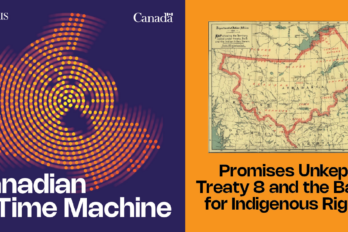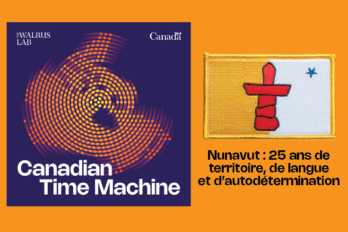SHOW NOTES:
SOURCES USED IN THIS EPISODE
The music for this episode is a licensed version of “This Podcast Theme” by InPlus Music. Additional music are licensed versions of “Stay Cool” by Loops Lab, and “Podcast Intro” by InPlus Music.
LINKS MENTIONED IN THIS EPISODE:
ADDITIONAL LINKS:
TRANSCRIPT:
SHEENA ROSSITER: Welcome to the deep dive from The Walrus, a weekly podcast that takes a deeper look into the happenings at The Walrus I’m Sheena Rossiter.
ANGELA MISRI: And I’m Angela Misri. On this week’s episode:
KC HOARD: The thing about these gay bars is they are political institutions. These are the places where our community survived together in our darkest hours in the eighties and nineties, during the AIDS crisis in the fifties and sixties during, you know, a time where it was legal or barely legal to be a homosexual.
ANGELA MISRI: The pandemic has made for difficult times for bars and nightclubs, many of which have had to shutter their doors. But it’s especially hard for gay bars, which have acted as safe spaces for the queer community for decades, and we’ll hear why.
SHEENA ROSSITER: This week we’ll hear from writer KC Hoard, whose work has appeared in the Globe and Mail, the National Post, Broadview Magazine, CBC Arts, and Xtra.
ANGELA MISRI: And then we’ll hear from Tim Singleton, who is an artist, designer and illustrator from Toronto. His work has appeared in The Washington Post, HuffPost, Adweek, and more.
SHEENA ROSSITER: Let’s check out your conversation with KC Hoard.
ANGELA MISRI: Can you explain how important gay bars are to the queer community?
KC HOARD: I guess I’ll start off by saying, I don’t pretend to speak for all people. What I can tell you is how vital they were for me personally. I mean, when I was coming-of-age as a young person, these bars were really where I felt like I could flourish, where I felt like I was part of something for the first time. I mean, I won’t give you my whole tragic backstory, but I definitely grew up in an environment like a lot of people where there weren’t a lot of people who were like me, just the environment of being in a gay bar, being in a place or, you know, that everybody is probably from the same community of you and at the very least is going to be affirming of you. It really does wonders for personal development and also community building. The thing about these gay bars is they are political institutions. These are the places where our community survived together in our darkest hours, in the eighties and nineties during the aids crisis in the fifties and sixties during, you know, a time where it was legal or barely legal to be a homosexual. These were a sanctuaries. It’s kind of a hard thing to capture and you know, one answer and I definitely had a lot of problems trying to capture the importance of these buildings in my long story.
ANGELA MISRI: The word you said in that early on is a place for you to flourish. As a South Asian who grew up in Calgary, one of the few people who identified as other, going to gay bars with my gay friends I found really freeing and safe. So I totally get that. Can you talk a little bit about the flourishing idea?
KC HOARD: I think so much of conversations about, I’m speaking broadly here, but like diversity, but, you know, I think specifically when it comes to and trans people, culturally we’re freaks. Queer and Trans people have always been treated as this kind of malignant, other, these depraved groups of people. So I think for a long time advocacy around LGBTQ+ rights has kind of been oriented around this idea of tolerance. It’s been oriented around this idea that, you know, straight people just need to coexist with us. Like we just want to be treated the same. And I think that that is a very virtuous aim. I think it is a very savvy political technique to ensure our rights, but queer people deserve to do more than just coexist with each other. Like queer people deserve to feel special. And we deserve to, like I said, flourish and belong to something that’s uniquely ours and allows us to really dive into who we are in a way that is not tethered in any way to straight people. That is what gay bars allow for. They allow for us to evolve and expand culturally and develop community with people who are going to lift us up and treat us with nuance when it comes to who we are.
ANGELA MISRI: It’s not just about being allowed to be around other people who are like you, but to also be safe, and to feel like this is special and this is a big deal. And we want to make it loud. So if gay bars are so important as safe spaces for the community, why are they starting to die off?
KC HOARD: It’s complicated. There’s a lot of things going on. I mean, first and foremost, the cost of living and the cost of operating a business has just skyrocketed in the past 20 years, especially when you are running a business that is community oriented. Gentrification has become such a, a parasitic issue in cities where gay bars are. And particularly in communities where gay bars are. Gay villages have become trendy. They were once not that whatsoever. Toronto’s gay village, for example, is, you know, a hot neighbourhood to open a business. To my knowledge, the gay bars in Toronto, at least in the village are doing just fine. Gentrification is encroaching on these businesses. The theories are that demand has waned for a lot of the gay bars due to a variety of things due to an increased level of tolerance for career people, socially, societally the rise in cruising at apps. These bars often one of their functions was for people to meet for, you know, romantic and sexual encounters. Now there are digital ways to get those things. It’s a variety of things.
ANGELA MISRI: Why is it especially upsetting for you that gay bars are closing because as we know, a lot of businesses are closing because of gentrification and the economy?
KC HOARD: To be honest with you, I think I was a lot more upset about this idea before I started reporting this story. And then as I kind of made my way through the story and developed a more detailed portrait of what the deal at these gay bars is. I think the thing with gay bars is, many of them haven’t really evolved in the last few decades. It’s the same business model. It’s the same attitudes towards what they are and how they serve their customer base. And a lot of these are rooted in a time where there were very normative, very white, very specific beauty standards within the gay community that these gay bars were catering to. I am to a degree upset that gay bars are being threatened in this way, because I do think that they are a profoundly important institution for the community to gather, to celebrate ourselves. I came out of writing this story, feeling complicated about what gay bars represent. I think that there’s a lot at stake when it comes to keeping these gay bars open been, but I’ve just really come to ask myself a lot of hard questions about what my stance is on these gay bars and where my stance is coming from culturally.
ANGELA MISRI: Could it be that some of the iconic gay bars that you know have shuttered recently and that might have prompted the writing of your story?
KC HOARD: The story is rooted in, uh, something a I wrote for Them, which is an American LGBT publication. They did this huge thing called the spaces project. It’s an ongoing series of brief eulogies to the spaces that have closed since the COVID-19 pandemic began. In America, it’s dozens of spaces. I was asked to write about the Beaver, which is mentioned in my Walrus piece. And it was a sort of alternative gay bar that decidedly catered to a customer base that was underrepresented in the more traditional, I’ll say, uh, gay bars of the downtown Toronto gay village. You know, it catered more to non-binary people who didn’t exactly fit within the binary gender spectrum. It catered to people who weren’t white to women. Where as a lot of the other gay bars were mainly catering to cisgender gay men. This was the place that kind of stood for everything that I’ve been talking about. Like it was truly a community hub. And so this was a place that really, really put queer and trans joy at the epicentre of what it stood for were. Um, and so I reported the story. It was pretty short and I just felt so inspired by the people that I spoke to that I kind of pitched this longer feature.
ANGELA MISRI: I enjoy that this place is called the Beaver, because that’s so Canadian and so very on-brand. During COVID-19 have other spaces popped up for the queer community to take the place of these gay bars that are closing down?
KC HOARD: It’s tough. The thing with a gay bar is that it is such a place that is rooted in physically gathering, right? Which is just not possible during this pandemic, not in the same way that it used to be. A lot of the things that have popped up have been digital, like in piece, I talk about speakeasy TV, which is a Twitch channel run by a Toronto drag queen that basically just live streams, digital drag content for the most part. And it has been a success it’s garnered some popularity and it’s kind of provided a kind of radically different, idea of what a queer space can be. It’s digital. So it eliminates a lot of the barriers to access that a normal gay bar would, which include, you know, just general accessibility. It’s not oriented around, you know, alcohol sex, it’s free to engage with it.
It doesn’t have like loud noises. These kinds of things that are so integral to what gay bars are just aren’t accessible for a lot of people. Something like that has really opened my eyes to what kind of the core tenants of gathering are and how they can evolve for, you know, the digital age. But in terms of physical spaces, I mean, I’m not personally aware of any spaces that have opened since the pandemic started. Part of the fear with queer spaces is that they’re only closing. I’d like to believe that there will always be these spaces, but it’s getting harder and harder open a gay bar. I don’t know what the future of them looks like.
ANGELA MISRI: Do you have any solutions in your story about saving these spaces?
KC HOARD: One idea that has been floated is this idea of embracing the old school historical preservation strategy and trying to get some of these queer spaces enshrined as historically important designated sites by the government. That has not been a success in Canada. It has been minorly successful in other or countries. The Stonewall in which you might be familiar with where the Stonewall riots took place in New York city was recently granted a historical site designation by the American government. And a place like the Royal Vauxhall Tavern, which is the London’s oldest gay bar also got a similar designation. But, frankly, solutions are few and far between. I mean, so much of it is just rooted in the fact that these are at the end of the day businesses. I tried to take a celebratory angle with the story, despite the fact that it is often a bit hard to swallow. If you’re attached to these gay bars. We have to take a reality check about what these institutions stand for and what their future might be.
SHEENA ROSSITER: And now here’s my conversation with Tim Singleton about the illustration for this article.
SHEENA ROSSITER: We spoke with KC about how gay bars had been a sort of sanctuary and places to flourish for the queer community. How did you want the image that you were illustrating to come across and how did that influence your decision of what you illustrated?
TIM SINGLETON: So well, the piece that KC wrote, there’s a sombre tone to it. It is heartbreaking what’s happening with so many venues and spaces. I didn’t want it to lose the magic that the queer community does have. So I still really wanted the visual to be special and impactful and just show how vibrant the community specifically the nightlife community really is.
SHEENA ROSSITER: And you’re known for drawing a lot of drag queens over the past. How did you kind of get into this gig? What was your discovery to get commissioned for this piece?
TIM SINGLETON: Ah, drag Queens, I think one really big universal thing for a lot of queer young people is: you come out, sometimes you do that before you’re legal drinking age, sometimes it’s after, but there’s always that rite of passage where you go to a gay bar, a space, whether that’s at like a university campus for a pride night or something like that. And there’s always a drag queen. So I feel like drag queens are really just like one of those ambassadors to the community. It’s one of your first experiences, your first voyage into being, you know, an out and proud member of the community is there’s always a drag queen somewhere nearby. I find them fabulous. I find them fascinating. I’m glad that we’re in an era where they’re finally kind of getting the credit they deserve. Whether you like it or not drag is going more mainstream, but I think it’s good that the we’re showing how much effort and how talented these individuals are. So I just love any kind of drag performer. And yeah, I’m always just really attracted to how they look, how they talk, how they perform. And they’re just like, how can you not want to draw them? They’re so they’re so wonderful looking.
SHEENA ROSSITER: So I have seen some of the mockups drag queen and all, and since this is a podcast, could you kind of describe what the original ideas for the illustration look like when you were kind of flushing out the concept for this illustration?
TIM SINGLETON: There’s a lot of very expected in imagery when there’s any kind of editorial on queerness, queer nightlife. It’s a lot of rainbows. It’s a lot of that kind of imagery. So I really wanted the idea of nightlife to be the centrepiece. That’s why drag queens do factor into it so much. And I also really wanted it to kind of blur the lines of harkening back to, you know, the prosperous years for spaces and also playing with the situation they found themselves in where villages aren’t the same thing that they were 10, 20, 30 years ago. The bars aren’t really condensed anymore. Oftentimes, especially in Toronto, they’re more spread out. So I really just wanted to show that kind of variety in it.
SHEENA ROSSITER: KC spoke with Angela. And he mentioned that gentrification has played a pretty significant role in these bars dying off. As you mentioned it, the piece kind of takes a bit more of a sombre tone because of this. How does that come across in your image?
TIM SINGLETON: I think one really important part of the image, and it was actually one that when I was working with Meredith who works at The Walrus and commissioned me for this piece, we were going back and forth. An original idea had just been a pair of scissors that were just kind of dangling over the scene. And weren’t really being wielded by anybody. And she suggested that the drag queen behold them, and at first I was a little hesitant, but then I was thinking about it and as sad as it is, a lot of the times a venue closes because the person in of it, normally a queer person they’re aware that it can’t happen anymore. They are the ones who are doing the books. They run the finances, they’re there, who’s opening and closing every night. So it’s that kind of sombre thing that gentrification does cause where it’s not like a bulldozer just showed up one day and knock this bar down. The owner had to close it. So I think there’s that importance in the image of showing that the performer is ultimately a part of taking down the disco ball, which is representative of, you know, like the party being over.
SHEENA ROSSITER: As a member of the community yourself. How does it make you feel that some of these spaces are closing?
TIM SINGLETON: Oh, it’s heartbreaking to be honest. The pandemic has just made…absence, makes the heart grow fonder. All I want to do go out to a bar and go dancing with my friends and just, you know, lose yourself in the night. I also just think that these are really important spaces and apps, websites, all of that stuff. It really can’t replace the feeling that you have when you go into a space that is full of queer people. And I think this is a pretty common thing. A lot of people when they’re younger and they come out, they’re a little nervous of spaces, because it’s a very overwhelming thing. You have a six foot six drag queen who is screaming from the stage. You have lights, you have drinks, you have all these people that you’ve never met before, kind of coming at you at once. And it’s something that you kind of have to be able to warm yourself up to and find your community in it. And that takes time. And so I just think it’s a shame when these places close, you kind of are losing that ability. You’re losing that option to have that kind of time.
SHEENA ROSSITER: That’s my conversation with illustrator Tim Singleton, and before that you heard Angela Misri’s conversation with writer KC Hoard. The editor for this story was Nicole Schmidt and the art direction for the illustration was done by Meredith Holigroski. You can read KC’s article and see Tim’s illustration for the story about the disappearance of gay bars on thewalrus.ca. You can find a link for the article in the show notes for this episode.
WHAT WE’RE TALKING ABOUT THIS WEEK AT THE WALRUS:
VILAYATH ALI: I’m Vilayath Ali, and here’s what we’ve been talking about this week at The Walrus.
We launched a new digital series on Friday, about wellness, and our first piece was written by our own Carine Abouseif. You can read her article about the evolution of the home workout – or listen to her chat about it on last week’s episode of The Deep Dive. Lots more to come in that series, so stay tuned.
We were also pretty excited to win two Canadian Online Publishing Awards – one we share with writer Pacinthe Mattar, who wrote about objectivity being reserved for the White journalists in her newsroom and another gold medal for best virtual event – our Poetry for the Moment Facebook Live.
Our Slack was full of hope as summer festivals started announcing their schedules, Massey Hall added in-person events for March, and we, like other Canadians, actually started to think we might see each other (safely) again soon. We can’t wait.
As always, the links for all these articles can be found in the show notes for this episode.
CREDITS:
SHEENA ROSSITER: Thanks for joining us on this week’s episode of the Deep Dive. This week’s episode was produced by Angela Misri, and me, Sheena Rossiter. It was also edited by me.
Thanks so much to KC Hoard and Tim Singleton for joining us on the podcast this week.
Music for this podcast is provided by Audio Jungle. Our theme song is “This Podcast Theme” by Inplus Music. Additional music is “Stay Cool” by Loops Lab, and “Podcast Intro” by Inplus Music. You also heard the tracks “Drone Trace Background”, “The Introvert”, “Turn the Lights On”, and “Piztey”, provided by Pixabay.
Don’t forget to subscribe to Deep Dive from The Walrus on Apple Podcasts, Spotify, or wherever you get your podcasts. And if you like what you heard, please leave us a review and rating. It really helps people find the podcast.
Until next week when we take our next deep dive.









